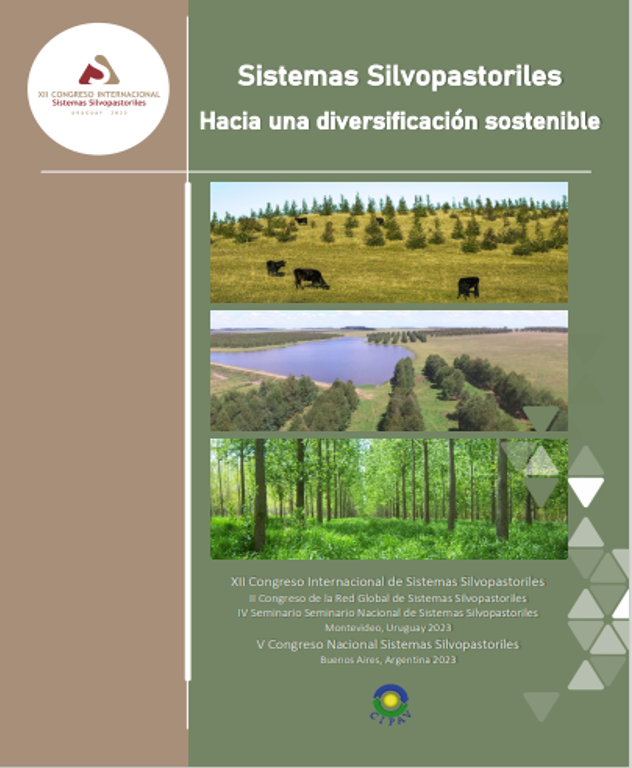Ver ítem
- xmlui.general.dspace_homeCentros Regionales y EEAsCentro Regional Tucumán - Santiago del EsteroEEA Santiago del EsteroPresentaciones a Congresosxmlui.ArtifactBrowser.ItemViewer.trail
- Inicio
- Centros Regionales y EEAs
- Centro Regional Tucumán - Santiago del Estero
- EEA Santiago del Estero
- Presentaciones a Congresos
- Ver ítem
Producción de Megathyrsus maximus y evaluación de parámetros productivos de una majada caprina en un Sistema silvopastoril del Chaco Semiárido
Resumen
This study aimed to evaluate the objective of goat meat production in Silvopastoral Systems, focusing on the response of the animal componen! and vegetat on behavior. The specifíc objetives included measuring forage availability and animal response through productive indicators. At the Francisco Cantos Experimental Field, affiliated with the EEA INTA Santiago del Estero, a silvopastoral module was implemented in 2007, based on a native forest in
[ver mas...]
This study aimed to evaluate the objective of goat meat production in Silvopastoral Systems, focusing on the response of the animal componen! and vegetat on behavior. The specifíc objetives included measuring forage availability and animal response through productive indicators. At the Francisco Cantos Experimental Field, affiliated with the EEA INTA Santiago del Estero, a silvopastoral module was implemented in 2007, based on a native forest in the semi-arid Chaco region. lnterventions were carried out to
maintain vegetation diversity, and Gatton Panic grass was sown to increase herbaceous forage availability. The dry matter avai ability of Megathyrsus moximus, measured in May during the period 2019-2022, showed sustained production ranging from 2000 to 3500 kgMS/ha without the need for reseeding. The animal component consisted of 20 adult Creole goats kept in the paddocks throughout the year. Kiddings were concentrated between October and November from 2019 to 2021. During critical production periods, no external feed supplementation was required as the goats exclusively fed on the forage provided by the system. Reproductive parameters showed a prolificacy rate of 178% and fertility rate of 88%, considered satisfactory for the region. The perinatal mortality rate was 7%, lower than in other non-mechanized systems, and the weaning rate was 165%. Goat production in SSP allowed to achieve productivities that improve the values mentioned in the existing bibliography and that come mainly from traditional production systems.
[Cerrar]
El presente estudio tuvo como objetivo evaluar el objetivo de la producción de carne caprina en Sistemas Silvopastoriles. Los objetivos específicos
incluyeron medir la disponibilidad de forraje y la respuesta animal a través de indicadores productivos. En el Campo Experimental Francisco Cantos, anexo a la EEA INTA Santiago del Estero, se implementó en 2007 un módulo silvopastoril, basado en un bosque nativo de la región del Chaco Semiárido. Se
[ver mas...]
El presente estudio tuvo como objetivo evaluar el objetivo de la producción de carne caprina en Sistemas Silvopastoriles. Los objetivos específicos
incluyeron medir la disponibilidad de forraje y la respuesta animal a través de indicadores productivos. En el Campo Experimental Francisco Cantos, anexo a la EEA INTA Santiago del Estero, se implementó en 2007 un módulo silvopastoril, basado en un bosque nativo de la región del Chaco Semiárido. Se realizaron intervenciones para mantener la diversidad de la vegetación y se sembró Megathyrsus maximus para incrementar la disponibilidad de forraje herbáceo. La disponibilidad de materia seca de la pastura fue medida en el mes de mayo durante el período 2019-2022 y mostró una producción sostenida desde los 2000 a 3500 kgMS/ha sin requerir resiembra. El componente animal estuvo constituido por 20 cabras criollas adultas mantenidas en los potreros durante todo el año. Los partos se concentraron entre octubre y noviembre de 2019 a 2021. Durante los períodos críticos de producción, no se requirió la suplementación alimenticia externa ya que las cabras pastorearon exclusivamente del forraje proporcionado por el sistema. Los animales mantuvieron estados nutricionales óptimos durante todo el ciclo de producción. Los parámetros reproductivos mostraron una tasa de prolificidad de 177% y una tasa de fecundidad de 88%, consideradas satisfactorias para la región. La tasa de mortal dad predestete fue del 7%, menor que en otros sistemas tradicionales poco tecnificados, y la tasa de destete fue del 165%.
[Cerrar]

Fuente
Sistemas silvopastoriles: Hacia una diversificación sostenible. XII Congreso Internacional De Sistemas Silvopastoriles, II Congreso de la Red Global de Sistemas Silvopastoriles, IV Seminario Nacional de Sistemas Silvopastoriles. Montevideo, Uruguay, 18 al 20 de octubre 2023. p. 248-254
Fecha
2023-10
Editorial
CIPAV
ISBN
978-628-95190-5-1
Formato
pdf
Tipo de documento
documento de conferencia
Palabras Claves
Derechos de acceso
Abierto
 Excepto donde se diga explicitamente, este item se publica bajo la siguiente descripción: Creative Commons Attribution-NonCommercial-ShareAlike 2.5 Unported (CC BY-NC-SA 2.5)
Excepto donde se diga explicitamente, este item se publica bajo la siguiente descripción: Creative Commons Attribution-NonCommercial-ShareAlike 2.5 Unported (CC BY-NC-SA 2.5)


